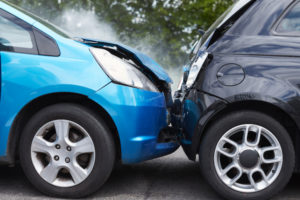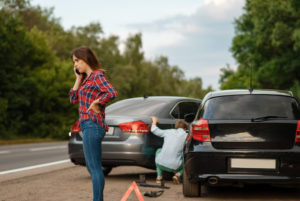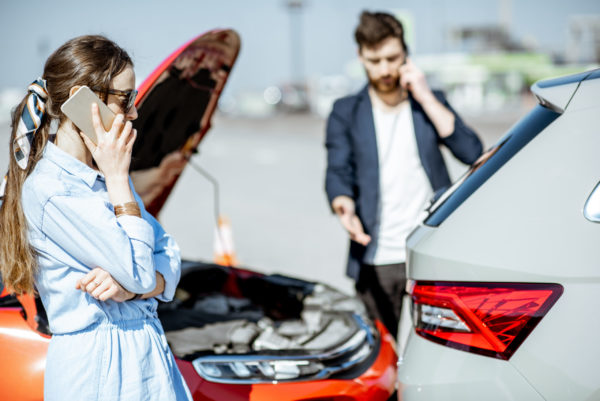Although many states have minimum legal requirements for liability car insurance, there are still many drivers on the road that are uninsured. Often, they will purchase the minimum legal required policy in order to register their vehicle, and then either cancel the policy or allow it to lapse without renewing.
In fact, according to the Insurance Research Council, nearly one in eight drivers on the road is driving around uninsured.
So, what happens if an uninsured driver hits you? Read on to find out how to protect yourself in this situation.
How Can You Protect Yourself in an Accident With Someone Who Is Uninsured?
With so many drivers out on the road without insurance, how can you protect yourself from the risk of being stuck without redress if you get in an accident with one of them?
The best way to protect yourself from this happening is to add uninsured or underinsured motorist coverage on your auto insurance policy. These optional add-on coverages can be the difference between being fully covered for your accident or paying out of pocket to cover your medical bills.
These coverages will not necessarily extend to property damage, however. If you want to be sure you can have your vehicle repaired through an insurance claim, you should consider adding collision coverage to your policy as well to avoid excessive out-of-pocket expenses.
What is the Major Difference Between Uninsured and Underinsured?
An uninsured motorist policy allows you to make a claim with your own insurance company in the event of an accident to help cover medical bills for injuries you sustain if you are hit by an uninsured driver. This type of insurance is not legally required in every state; however, insurance companies are legally required to offer this type of coverage as an option for their customers.
One thing to consider when updating your insurance policy with add-ons is that uninsured motorist coverage is usually limited to the amount of your standard liability coverage. If you only have $25,000 per accident in liability coverage, then you will only be able to add a maximum of $25,000 in uninsured motorist coverage.
One way to increase the coverage you have without increasing your premium is stacking your insurance coverage, which multiplies the coverage by the number of vehicles in your household. If you would prefer to mitigate your risks by adding additional coverage, this will be the ideal moment to assess your coverage amount.
When considering additional coverage, it might also be advantageous to consider underinsured motorist coverage. Many drivers choose to opt for the lowest available amount of coverage that allows them to register their vehicle. If you happen to get into an accident with someone who has only $10,000 in liability coverage, this amount will likely not be sufficient to cover the costs you incur as a result of the accident.
Underinsured motorist coverage allows you to claim against your own policy for any expenses that the insurance of the at-fault driver does not cover. Adding this to your policy can provide you peace of mind on the road. While this coverage is also not required, it is required by law for your insurance company to offer this type of coverage to you as an option.

How Can Collision Coverage Help?
Uninsured and underinsured motorist coverage often does not extend to property damage expenses. This is something you will need to confirm with your insurance company.
If the coverage does not extend to property damage, you may want to consider adding collision coverage to your policy as well. This will ensure that you are able to make a property damage claim after an accident if you are hit by an uninsured or underinsured driver, or are even involved in a hit and run accident. It provides another level of protection for you to ensure that you cover all your potential expenses, reducing the risk that you may incur excessive out-of-pocket expenses.
What You Should Do If You Have Been Involved In An Accident With An Uninsured Or Underinsured Driver
Driving is not an inherently dangerous activity if a car is in the right hands. However, there is an ever-present risk of being involved in an accident. If you happen to be involved in an accident and the other driver has a look of abject panic when you ask for their insurance information, chances are high that they are uninsured.
So, what happens if an uninsured driver hits you? It is important to consider the correct actions to take after an accident. This will ensure that you have covered all your bases and are able to pursue a claim through your own uninsured motorist coverage.
If you get in an accident with an uninsured driver, remain calm and follow the undermentioned steps…
1. Do Not Accept Payment at the Scene
If the at-fault driver in your accident does not have insurance, they will likely face hefty fines or fees, in addition to the cost of the citation issued by the police, for failing to maintain the legally required minimum amount of insurance coverage for their vehicle. They may try to offer you money at the scene in exchange for your cooperation in not notifying the authorities. However, at this point, you will not know exactly what the costs associated with this accident may be. Do not accept money from the other driver and continue by filing an official record of the accident with the police.
2. Call the Police
Regardless of whether the other driver has insurance or not, it is always a best practice to call the police. This ensures that there is an official record of the accident and provides information on which driver is at fault.
Having an official record of the accident will make the process of making a claim with your insurance company smoother. This will in turn help ensure that you get your expenses covered. Be sure to get the name and badge number of the responding officer. This will likely be included in the accident report.
3. Exchange Information at the Scene
Make sure that a driver’s information exchange occurs at the scene. The police will often provide an official exchange to each driver in addition to the accident report when they are called.
Make sure that if they do not provide this information to you, you exchange information with the other driver yourself. Although they may not have insurance, you will still need this information in order to file a claim with your own insurance company. Be sure to include their vehicle information, driver’s license information, and phone number.
4. Write Down Details of the Incident
Whenever possible, be sure to include the exact details of the accident. Write down the date and time, and the exact location of the incident. If it occurs along a roadway, include the nearest major intersection or landmark for location reference.
Write down the year, make, and model of the vehicle that hit you, as well as the license plate number. If there were any eyewitnesses to the accident, get their contact information and save it in a safe location. Eyewitnesses are important to recreating the scene of the accident for a jury.

Can I File a Lawsuit Against an Uninsured Driver?
Yes, it is absolutely possible to sue an uninsured driver. However, an uninsured driver may not have sufficient assets to cover your expenses. The primary reason that drivers choose to either cancel their insurance coverage or let their policy lapse without renewing is that they want to avoid the cost of their premiums.
Accordingly, it is likely that they will not have any assets to recover from. Even in the event that a lawsuit against them is successful, it may not be worth the costs associated with filing suit. Contact a personal injury attorney at Carey Leisure Carney for advice. They can help you decide on the best way to move forward with your claim.
How Can Carey Leisure Carney Help?
If you find yourself in the position of being in an accident with an uninsured or underinsured driver and are not sure what your redress is, call Carey Leisure Carney for a free consultation. Our attorneys will be able to discuss your situation and offer qualified advice on your next steps. Give our team a call today!
